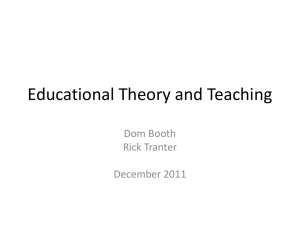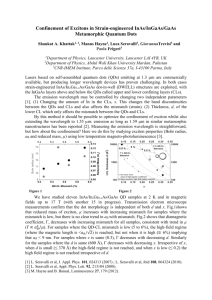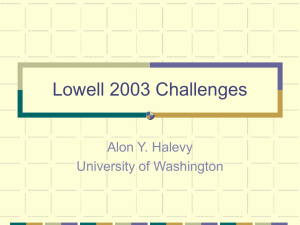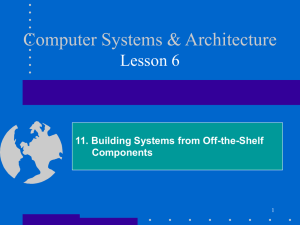OPSM 901: Operations Management
advertisement
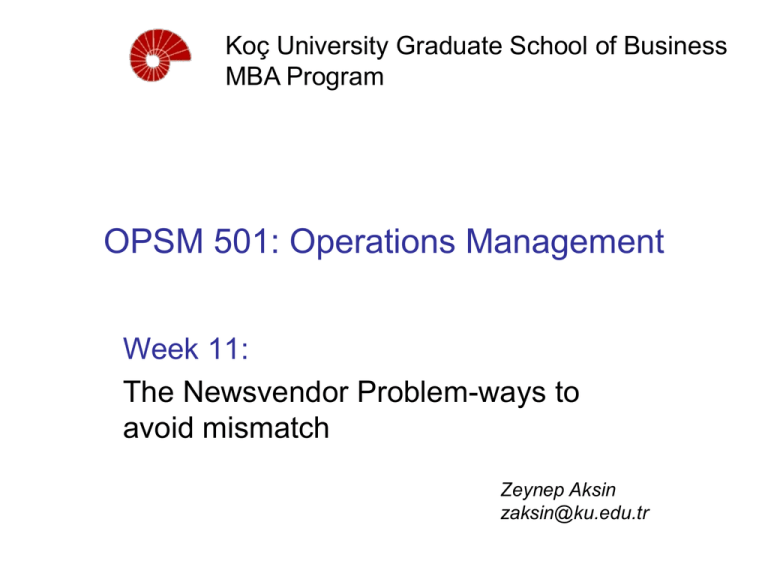
Koç University Graduate School of Business MBA Program OPSM 501: Operations Management Week 11: The Newsvendor Problem-ways to avoid mismatch Zeynep Aksin zaksin@ku.edu.tr Hammer 3/2 timeline and economics Generate forecast of demand and submit an order to TEC Spring selling season Nov Dec Jan Feb Mar Apr May Jun Receive order from TEC at the end of the month Jul Aug Economics: • Each suit sells for p = $180 • TEC charges c = $110 per suit • Discounted suits sell for v = $90 Left over units are discounted The “too much/too little problem”: – Order too much and inventory is left over at the end of the season – Order too little and sales are lost. Marketing’s forecast for sales is 3200 units. The demand-supply mismatch cost Definition – the demand supply mismatch cost includes the cost of left over inventory (the “too much” cost) plus the opportunity cost of lost sales (the “too little” cost): Mismatch cost Co Expected left over inventory Cu Expected lost sales The maximum profit is the profit without any mismatch costs, i.e., every unit is sold and there are no lost sales: Maximum profit p c The mismatch cost can also be evaluated with Mismatch cost = Maximum profit – Expected profit Revisit Example 3: Manufacturing cost=60TL, Selling price=80TL, Discounted price (at the end of the season)=50TL Market research gave the following probability distribution for demand. Find the optimal q, expected number of units sold for this orders size, and expected profit, for this order size. Demand 500 600 700 800 900 1000 1100 Probability 0.10 0.2 0.2 0.2 0.10 0.10 0.10 P(D<=n-1) 0 0.1 0.3 0.5 0.7 0.8 0.9 Cu=20 Co=10 P(D<=n-1)<=20/30=0.66 <=0.66 q=800 For q=800: E(units sold)=710 E(profit)=13,300 Max profit=20*770=15400 When is the mismatch cost high? Hammer 3/2’s mismatch cost as a percentage of the maximum profit is $31,680/$223,440 = 14.2% Mismatch cost as a percent of the maximum profit increases as … – (1) the coefficient of variability of demand increases – (2) the critical ratio decreases Critical ratio Coefficient of variation 0.10 0.25 0.40 0.55 0.70 0.85 1.00 0.4 10% 24% 39% 53% 68% 82% 97% 0.5 8% 20% 32% 44% 56% 68% 80% 0.6 6% 16% 26% 35% 45% 55% 64% 0.7 5% 12% 20% 27% 35% 42% 50% 0.8 3% 9% 14% 19% 24% 30% 35% 0.9 2% 5% 8% 11% 14% 17% 19% Options to reduce the mismatch cost Make to order Reactive Capacity – Unlimited – Limited Make-to-Stock Model Suppliers Assembly Configuration 7 Assemble-to-Order Model Suppliers Assembly Configuration 8 Unlimited, but expensive reactive capacity TEC charges a premium of 20% per unit ($132 vs. $110) in the second order. There are no restrictions imposed on the 2nd order quantity. O’Neill forecast of total season sales is nearly perfect after observing initial season sales. How many units should O’Neill order in October? 12-9 Revisit Example 2: Finding Cu and Co A textile company in UK orders coats from China. They buy a coat from 250€ and sell for 325€. If they cannot sell a coat in winter, they sell it at a discount price of 225€. When the demand is more than what they have in stock, they have an option of having emergency delivery of coats from Ireland, at a price of 290. The demand for winter has a normal distribution with mean 32,500 and std dev 6750. How much should they order from China?? Example 2: Finding Cu and Co A textile company in UK orders coats from China. They buy a coat from 250€ and sell for 325€. If they cannot sell a coat in winter, they sell it at a discount price of 225€. When the demand is more than what they have in stock, they have an option of having emergency delivery of coats from Ireland, at a price of 290. The demand for winter has a normal distribution with mean 32,500 and std dev 6750. How much should they order from China?? Cu=75-35=40 Co=25 F(z)=40/(40+25)=40/65=0.61z=0.28 q=32500+0.28*6750=34390 Apply Newsvendor logic even with a 2nd order option The “too much cost” remains the same: – Co = c – v = 110 – 90 =20. The “too little cost” changes: – If the 1st order is too low, we cover the difference with the 2nd order. – Hence, the 2nd order option prevents lost sales. – So the cost of ordering too little per unit is no longer the gross margin, it is the premium we pay for units in the 2nd order. • Cu = 132 – 110 = 22 Cu 22 0.5238 Co Cu 20 22 Critical ratio: Corresponding z-statistic F(0.05)=0.5199, F(0.06)=0.5239, so z = 0.06. Q z 3192 0.06 1181 3263 Profit improvement due to the 2nd order option With a single ordering opportunity: – Optimal order quantity = 4101 units – Expected profit = $191,760 – Mismatch cost as % of revenue = 4.9% The maximum profit is unchanged = $223,440 With a second order option: – Optimal order quantity = 3263 units Expected profit Maximum profit - Co Expected left over inventory Cu Expected second replenishm ent quantity $223,440 $20 508 $22 437 $203,666 – Reduction in mismatch cost = 38% (19,774 vs 31,680) – Mismatch cost as % of revenue = 3.1% Limited reactive capacity Units in the 2nd order are no more expensive than in the 1st order But there is limited capacity for a 2nd order Sport Sample of wetsuits Model DIVE DIVE COMP 3/2 FULL DIVE WMS 7000X 7MM FULL SURF EPIC 5/3 W/HD SURF HEAT 3/2 SURF HEATWAVE 4/3 SURF ZEN-ZIP 4/3 TRIATHLON TRIATHLON 4/3 FULL WAKE-BOARD REACTOR 3/2 WINDSURF CYCLONE 4/3 WINDSURF WMS EVOLUTION 4/3 = expected demand 1100 660 600 360 800 296 1200 444 700 259 3100 1147 2600 1690 1500 750 950 665 850 595 0.60 0.60 0.37 0.37 0.37 0.37 0.65 0.50 0.70 0.70 Price Margin Discount 120 275 225 110 140 165 210 150 325 275 38% 38% 38% 38% 38% 38% 45% 45% 45% 45% 65% 65% 50% 50% 50% 50% 65% 65% 65% 65% = standard deviation of demand Price = wholesale price Margin = gross margin as a % of price Discount = anticipated end of season discount as % of price to sell left over inventory 1st order must be at least 10,200 suits so that there is enough capacity for the 2nd order. Also a minimum order quantity-order once What should we produce in the 1st order? Profit and mismatch with only 1 ordering opportunity Use the Newsvendor model to evaluate the optimal order quantity, expected profit, maximum profit and mismatch cost Sport DIVE DIVE SURF SURF SURF SURF TRIATHLON WAKE BOARD WINDSURF WINDSURF Total Model DIVE COMP 3/2 FULL WMS 7000X 7MM FULL EPIC 5/3 W/HD HEAT 3/2 HEATWAVE 4/3 ZEN-ZIP 4/3 TRIATHLON 4/3 FULL REACTOR 3/2 CYCLONE 4/3 WMS EVOLUTION 4/3 Order quantity 1241 677 1009 1514 883 3910 3449 1877 1284 1149 16993 Expected Maximum Mismatch profit profit cost $30,086 $50,160 $20,074 $37,608 $62,700 $25,092 $58,048 $68,400 $10,352 $42,568 $50,160 $7,592 $31,604 $37,240 $5,636 $164,953 $194,370 $29,417 $164,582 $245,700 $81,118 $75,536 $101,250 $25,714 $89,538 $138,938 $49,399 $67,788 $105,188 $37,399 $762,311 $1,054,105 $291,794 12-16 Produce “safer” products early, produce “risky” products with reactive capacity Sort items by their mismatch cost to order quantity ratio. Fill the 1st order up to the minimum quantity (10,200) with the items that have the lowest mismatch – quantity ratio Order quantity Model HEAT 3/2 1514 HEATWAVE 4/3 883 ZEN-ZIP 4/3 3910 EPIC 5/3 W/HD 1009 REACTOR 3/2 1877 DIVE COMP 3/2 FULL 1241 TRIATHLON 4/3 FULL 3449 WMS EVOLUTION 4/3 1149 WMS 7000X 7MM FULL 677 CYCLONE 4/3 1284 Total 16993 Newsvendor expected Mismatch profit cost $42,568 $7,592 $31,604 $5,636 $164,953 $29,417 $58,048 $10,352 $75,536 $25,714 $30,086 $20,074 $164,582 $81,118 $67,788 $37,399 $37,608 $25,092 $89,538 $49,399 $762,311 $291,794 Mismatch costorder quantity First order ratio quantity Profit 5.0 1514 $42,568 6.4 883 $31,604 7.5 3910 $164,953 10.3 1009 $58,048 13.7 1877 $75,536 16.2 1241 $30,086 23.5 0 $245,700 32.6 0 $105,188 37.1 0 $62,700 38.5 0 $138,938 10434 $955,320 12-17 Push-Pull Supply Chains The Supply Chain Time Line Customers Suppliers PUSH STRATEGY Low Uncertainty PULL STRATEGY High Uncertainty Push-Pull Boundary 18 A new Supply Chain Paradigm A shift from a Push System... – Production decisions are based on forecast …to a Push-Pull System – Parts inventory is replenished based on forecasts – Assembly is based on accurate customer demand 19 Demand Forecast The three principles of all forecasting techniques: – Forecasts are always wrong – The longer the forecast horizon the worst is the forecast – Aggregate forecasts are more accurate • The Risk Pooling Concept 20 Business models in the Book Industry From Push Systems... – Barnes and Noble ...To Pull Systems – Amazon.com, 1996-1999 And, finally to Push-Pull Systems – Amazon.com, 1999-present • Around 40 warehouses 21 Business models in the Grocery Industry From Push Systems... – Supermarket supply chain ...To Pull Systems – Peapod, 1989-1999 • Stock outs 8% to 10% And, finally to Push-Pull Systems – Peapod, 1999-present • Dedicated warehouses • Stock outs less than 2% 22 Locating the Push-Pull Boundary 23 Organizational Skills Needed Raw Material Customers Push Pull Low Uncertainty High Uncertainty Long Lead Times Short Cycle Times Cost Minimization Service Level Resource Allocation Responsiveness 24 O’Neill: quick response (reactive capacity) Low Risk: Push Speculative Production capacity Initial forecast High Risk: Push-Pull Reactive Production capacity Later orders 25 Announcement Read the HP case for next week We will analyze it in-class Bring your laptops!
